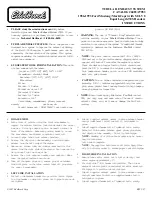
ENCENDIDO DE MOTOR A CONTROL REMOTO
LEXUS
Página 1
El E
NCENDIDO DE
M
OTOR A
C
ONTROL
R
EMOTO
le permite encender el motor de su vehículo
desde fuera de éste. Utiliza el control remoto para abrir las puertas de su auto, por lo que no
es necesario cargar encima ningún otro control remoto adicional. Este E
NCENDIDO DE
M
OTOR A
C
ONTROL
R
EMOTO
, opera de la misma forma para los vehículos equipados o no con el sistema
Entrada Inteligente (Smart Entry) o Arranque de Botón (Push Start); simplemente presione en
su control remoto el botón para cerrar los seguros, en una secuencia rápida de dos pasos.
Adicionalmente, el E
NCENDIDO DE
M
OTOR A
C
ONTROL
R
EMOTO
puede activar ya sea la calefac-
ción o el aire acondicionado, proporcionándole un habitáculo agradable al momento de entrar
a su vehículo. Como una conveniencia adicional, el E
NCENDIDO DE
M
OTOR A
C
ONTROL
R
EMOTO
puede también activar el desempañador (cuando haya sido previamente activado), para
aclarar el parabrisas durante climas fríos.
Para garantizar su seguridad como la de cualquier otra persona que se encuentre cerca del
vehículo, el E
NCENDIDO DE
M
OTOR A
C
ONTROL
R
EMOTO
está diseñado para apagar inmediata-
mente el motor, en caso de que se detecte algún intento de entrar o mover el vehículo, de-
spués de un arranque a distancia. Por favor consulte a su distribuidor Lexus para mayores
detalles.
NOTA: Para poder utilizar el E
NCENDIDO DE
M
OTOR A
C
ONTROL
R
EMOTO
, su vehículo debe contar
con una caja de transmisión automática; no puede ser usado en automóviles con cajas de
cambios manuales. El rango de transmisión para el arrancado a distancia podría ser menor
que el de la operación básica de apertura de puertas a distancia. El rango puede también
verse afectado por el medio ambiente de alrededor. Las leyes en algunas comunidades es-
tablecen que el vehículo debe encontrarse dentro del rango de visión, de la persona que esté
usando el E
NCENDIDO DE
M
OTOR A
C
ONTROL
R
EMOTO
. En algunos estados, el uso del E
NCENDIDO
DE
M
OTOR A
C
ONTROL
R
EMOTO
podría violar leyes locales o estatales. Antes de usar su E
NCEN
-
DIDO DE
M
OTOR A
C
ONTROL
R
EMOTO
, verifique las leyes en su estado y localidad.
Para cualquier pregunta o asunto relacionado con el E
NCENDIDO DE
M
OTOR A
C
ONTROL
R
EMOTO
,
por favor llame a Relaciones de Clientes
LEXUS
, al (800) 255 3987.
INTRODUCCIÓN
LEXUS
REMOTE ENGINE STARTER
Page 1
The R
EMOTE
E
NGINE
S
TARTER
allows you to start your engine from outside the vehicle. It utilizes
your vehicle’s keyless entry remote, so there is no need to carry around an extra remote. The
R
EMOTE
E
NGINE
S
TARTER
is operated the same way for vehicles equipped with or without the
Smart Entry / Push Start system; simply push the remote’s LOCK button in a quick, two-step
sequence. In addition, the R
EMOTE
E
NGINE
S
TARTER
can activate the heater or air conditioner
according to your preset temperature controls, providing you with a comfortable cabin upon
entry. As an added convenience, the R
EMOTE
E
NGINE
S
TARTER
can also activate the defroster
(when preset) to clear up the windshield during cold weather.
To ensure your safety, and the safety of anyone near the vehicle, the R
EMOTE
E
NGINE
S
TARTER
is designed to shut the engine off when it detects any attempt to enter or move the vehicle
after a remote engine start. Please consult your Lexus dealer for more details.
NOTE: To utilize the R
EMOTE
E
NGINE
S
TARTER
, your vehicle must have an automatic transmis-
sion; it cannot be used for manual transmission models. The transmission range for remote
start may be shorter than the remote’s basic keyless entry operation. Range can also be af-
fected by the surrounding environment. Laws in some communities require that the vehicle be
within view of anyone using the R
EMOTE
E
NGINE
S
TARTER
. In some states, use of the R
EMOTE
E
NGINE
S
TARTER
may violate state or local laws. Before using the R
EMOTE
E
NGINE
S
TARTER
,
check your state and local laws.
For any questions or concerns about the R
EMOTE
E
NGINE
S
TARTER
, please call Lexus Customer
Relations at (800) 255-3987.
INTRODUCTION






























